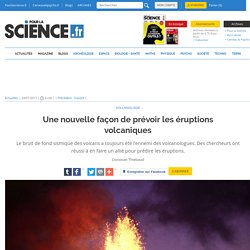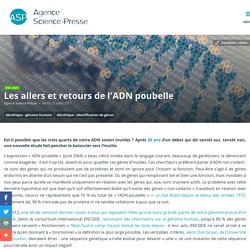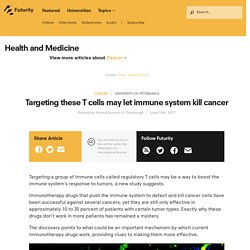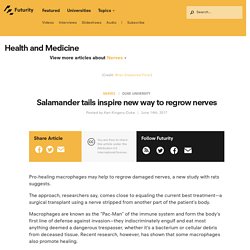

Le génome des Papous, mémoire de l'humanité. Et si les secrets des origines de l'humanité étaient nichés au cœur de l'ADN des Papous ?

Le projet Papuan Past combine des approches archéologiques et génomiques pour comprendre comment se sont établies et adaptées les populations humaines au cours des 50 derniers millénaires en Papouasie-Nouvelle-Guinée. « Là-bas, si l'on veut emprunter la pirogue ou se laver dans la rivière, il vaut mieux le faire en pleine journée, car dès 18 heures, ils sortent. Émissions de gaz à effet de serre : certains barrages sont pires que des centrales à charbon ! L'énergie hydroélectrique est la première source d'énergie renouvelable dans le monde.

Une énergie réputée verte qui encourage la multiplication des projets de grands barrages. Pourtant, certaines constructions s'avèrent très émettrices de méthane et de dioxyde de carbone, en raison de la décomposition de matière organique dans les réservoirs. Une nouvelle façon de prévoir les éruptions volcaniques. En 79 de notre ère, la ville de Pompéi est entièrement ravagée par l’éruption du Vésuve, l’un des volcans les plus célèbres et les plus dangereux du globe.

Même s’il est actuellement en sommeil, de nombreux autres sont en activité dans le monde. Les allers et retours de l'ADN poubelle. L’expression « ADN poubelle » (junk DNA) a beau s’être invitée dans le langage courant, beaucoup de généticiens la dénoncent comme exagérée : il est trop tôt, disent-ils pour qualifier ces gènes d'inutiles.

Ces chercheurs préfèrent parler d'ADN non codant : ce sont des gènes qui ne produisent pas de protéines et dont on ignore pour l'instant la fonction. Peut-être s’agit-il de gènes endormis en attente d’un besoin qui ne s’est pas présenté. To survive cold, some plants kill part of their roots. Some plants may selectively kill part of their roots in order to survive cold weather conditions, researchers have found.

A venomous paradox: how deadly are Australia's snakes? Australia is renowned worldwide for our venomous and poisonous creatures, from snakes, spiders and ticks on land, to lethal jellyfish, stingrays and stonefish in our waters.

Even the shy platypus can inflict excruciating pain if handled without due care. Yet while injuries and deaths caused by venomous snakes and jellyfish are often sensationalised in the media, and feared by international visitors, a recent review found that very few “deadly” Australian animals actually cause deaths. Targeting these T cells may let immune system kill cancer. Targeting a group of immune cells called regulatory T cells may be a way to boost the immune system’s response to tumors, a new study suggests.

Immunotherapy drugs that push the immune system to detect and kill cancer cells have been successful against several cancers, yet they are still only effective in approximately 10 to 30 percent of patients with certain tumor types. Exactly why these drugs don’t work in more patients has remained a mystery. The discovery points to what could be an important mechanism by which current immunotherapy drugs work, providing clues to making them more effective. Why did humans evolve such large brains? Because smarter people have more friends.
Humans are the only ultrasocial creature on the planet.

We have outcompeted, interbred or even killed off all other hominin species. We cohabit in cities of tens of millions of people and, despite what the media tell us, violence between individuals is extremely rare. Salamander tails inspire new way to regrow nerves. Pro-healing macrophages may help to regrow damaged nerves, a new study with rats suggests.

The approach, researchers say, comes close to equaling the current best treatment—a surgical transplant using a nerve stripped from another part of the patient’s body. Macrophages are known as the “Pac-Man” of the immune system and form the body’s first line of defense against invasion—they indiscriminately engulf and eat most anything deemed a dangerous trespasser, whether it’s a bacterium or cellular debris from deceased tissue.
Recent research, however, has shown that some macrophages also promote healing. Eye-opening picture of fetal immune system emerges. Chromosome cooperation is long-distance endeavor. Multiple genomic elements work cooperatively and over long distances in order to ensure the proper functioning of chromosomes, a team of scientists has found.

Its research offers new insights into the complexity of gene regulation. CRISPR controversy raises questions about gene-editing technique. Why Is Synaptic Pruning Important for the Developing Brain? One of the grand strategies nature uses to construct nervous systems is to overproduce neural elements, such as neurons, axons and synapses, and then prune the excess. In fact, this overproduction is so substantial that only about half of the neurons mammalian embryos generate will survive until birth. Scientists jump hurdle in HIV vaccine design. Scientists at The Scripps Research Institute (TSRI) have made another important advance in HIV vaccine design.
The development was possible thanks to previous studies at TSRI showing the structures of a protein on HIV's surface, called the envelope glycoprotein. The scientists used these structures to design a mimic of the viral protein from a different HIV subtype, subtype C, which is responsible for the majority of infections worldwide. The new immunogen is now part of a growing library of TSRI-designed immunogens that could one day be combined in a vaccine to combat many strains of HIV.
How dinosaurs may have evolved into birds. Evolutionary biologists have suspected that anatomical differences within and between species are caused by cis-regulatory elements (CREs). CREs are regions of genome DNA that do not code for proteins, and control morphology and other traits by regulating genes. The international group of researchers analyzed the genomes of 48 avian species that represent the evolutionary history of modern birds and compared them to many other vertebrates to find DNA sequences specific to avians.
Large study uncovers genes linked to intelligence. Exactly what constitutes intelligence, and to what extent it is genetic, are some of the most controversial questions in science. But now a new study of nearly 80,000 people, published in Nature Genetics, has managed to identify a number of genes that seem to be involved in intelligence. According to a dictionary definition, intelligence is “the ability to learn, understand or deal with new situations” or “the ability to apply knowledge to manipulate one’s environment or to think abstractly”. This is obviously quite broad. Indeed, even animals display a number of different forms of intelligence, typically critical for survival.
Our 'selfish' genes contain the seeds of our destruction – but there might be a fix. The human race is in so much trouble that it needs to colonise another planet within 100 years or face extinction. So says the physicist Stephen Hawking in an upcoming BBC documentary, Stephen Hawking: Expedition New Earth. According to Hawking, “with climate change, overdue asteroid strikes, epidemics and population growth, our own planet is increasingly precarious”. If this makes you nervous, it should. Colonising another planet will be much easier said than done, and lots of people would likely be left behind to face whichever disaster comes first.
Knowledge gap on the origin of sex. There are significant gaps in our knowledge on the evolution of sex, according to a research review on sex chromosomes from Lund University in Sweden. Even after more than a century of study, researchers do not know enough about the evolution of sex chromosomes to understand how males and females emerge.
Greater focus on ecological aspects would increase this knowledge, according to evolutionary biologists at Lund University, who have reviewed a lot of the research conducted in this field in the last 100 years. Female and male bodies work differently, even though they have the same genome. Mapping the proteome. Tiny shells indicate big changes to global carbon cycle: Future conditions not only stress marine creatures but also may throw off ocean carbon balance. Experiments with tiny, shelled organisms in the ocean suggest big changes to the global carbon cycle are underway, according to a study from the University of California, Davis. For the study, published in the journal Scientific Reports, scientists raised foraminifera -- single-celled organisms about the size of a grain of sand -- at the UC Davis Bodega Marine Laboratory under future, high CO2 conditions.
These tiny organisms, commonly called "forams," are ubiquitous in marine environments and play a key role in food webs and the ocean carbon cycle. D'où vient la couleur des yeux ? C'est la quantité de mélanine contenue dans l'iris qui détermine la couleur des yeux. La couleur de nos yeux, nous la devons à un pigment foncé qui s'appelle la mélanine. On trouve également la mélanine dans la peau et dans les cheveux. C'est en fait la concentration plus ou moins élevée de cet unique pigment qui détermine la couleur de nos yeux.
Une concentration qui est définie de manière assez complexe, par l'expression de plusieurs gènes. Parfois, les deux iris peuvent être de couleurs différentes. A new T-cell population for cancer immunotherapy. Birds, bees and other critters have scruples, and for good reason. Feather Fancy - Video. DNA vaccine protects against toxic proteins linked to Alzheimer's.
A new DNA vaccine when delivered to the skin prompts an immune response that produces antibodies to protect against toxic proteins associated with Alzheimer's disease -- without triggering severe brain swelling that earlier antibody treatments caused in some patients. Two studies from the Peter O'Donnell Jr. Comment les cyanobactéries ont commencé à respirer.